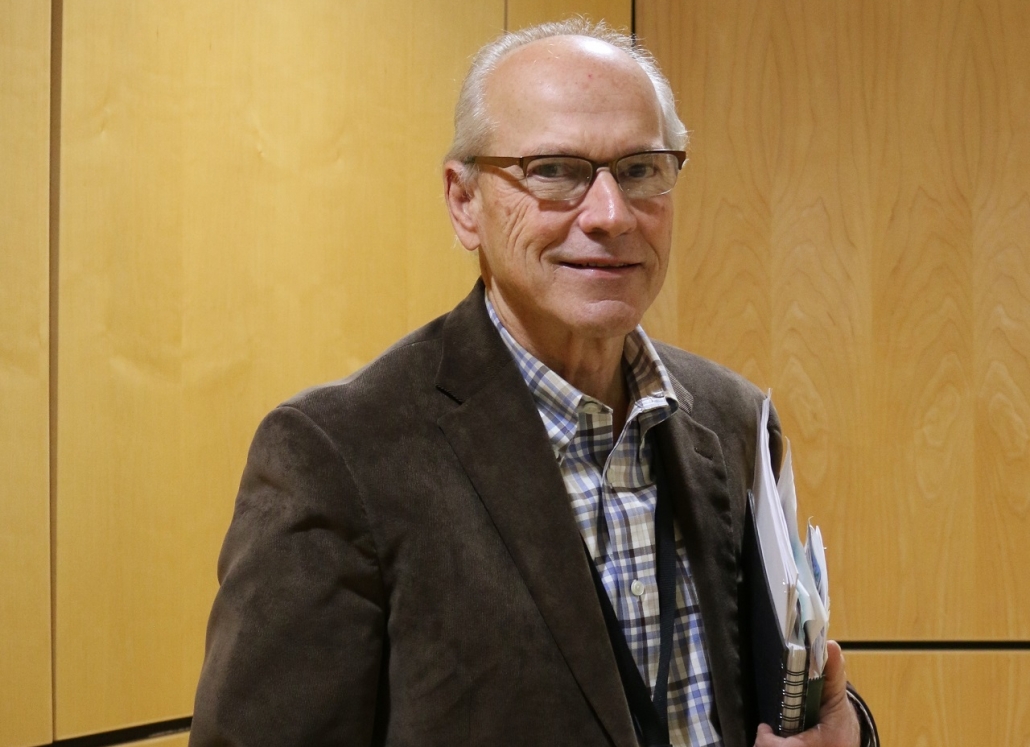Opioid Crisis Response: A plan of compassion, connection and communities

Gordon Smith, the executive director of the Maine Opioid Crisis Response task force. Photo by Jeanne Marquis.
by Jeani Marquis
The Maine Opioid Response Strategic Action Plan has five focus areas – Leadership, Prevention, Overdose Rescue, Treatment and Recovery – all leading to one goal. That goal is to reduce the negative health and economic impacts of substance-use disorder (SUD) and opioid-use disorder (OUD) on individuals, families and communities in Maine. The action plan reflects the understanding that substance abuse impacts the rural areas of the state as much as the urban.
“This is a chronic disease,” explains Gordon Smith, the executive director of the Maine Opioid Crisis Response task force, “we need to break down the stigma to stop shaming people for using drugs, encourage them, love them and wrap our arms around them and get them into recovery.”
The first of the five focus areas of the action plan provides strong state level Leadership using evidence-based and community-focused actions in response to Maine’s opioid crisis. State leadership means breaking down the silos between existing agencies to eliminate duplication and focus resources where they are needed. The Opioid Response, Prevention and Recovery Cabinet is comprised of representatives from Maine’s Department of Health and Human Services (DHHS), Law enforcement agencies, other related state departments, an affected family member, person in recovery and the state’s Attorney General. Under their leadership, efforts will be made to increase the public understanding and reduce the stigma of substance and opioid use disorder.
The second of the five focused areas is prevention — working to deter our state’s youth from using addictive substances in the first place. The plan calls for preventive programs in our schools and not stopping there but also reaching out to community and youth organizations. Youth organizations play an important role in establishing self-esteem and decision-making skills needed to build resilient youth.
Community social services can identify and address adverse childhood experiences that can lead to future drug use if not addressed early in a child’s life. In some cases, prevention needs to begin before a child is born to a mother who is a substance abuser. In 2018, 904 children in Maine were born substance exposed. Maine is one of 10 states receiving a $5.3 million federal grant to help substance-exposed babies and their mothers to create more positive outcomes and lower future statistics. This grant funds the Maternal Opioid Misuse (MOM) Initiative at the maternity department at hospitals throughout Maine: Maine General Medical Center, Maine Health, Mid Coast-Parkview Hospital, Northern Light Health, Penobscot Community Health Care and Pines Health Services. Pregnant substance users are urged to seek care with MOM program early in their pregnancy.
The third focus of the Opioid Crisis Response Plan is Overdose Rescue. The primary motivation is to keep the substance users alive so they can get into treatment. The task force is distributing 35,000 doses of naloxone to law enforcement, emergency responders, recovery center, correctional facilities and overdose prevention programs. To support the distribution of naloxone, the task force is providing education on overdose prevention, how to identify an overdose and how to administer naloxone. The task force wants to encourage families who have a loved one who is struggling with opioid addiction to ask their physician how to obtain naloxone for their household and get training on its use.
The fourth focus is to ensure that treatment is local, immediate and affordable. The plan is to get users into Medicated-Assisted Treatment (MAT) as soon as possible after a crisis by supporting emergency rooms and county jails in adding MAT programs. Medicated-Assisted Treatment is the use of FDA-approved medications to ease cravings and withdrawals, in combination with counseling and behavioral therapies. The task force is also working to increase MAT providers and shorten the long waits to entering treatment plans. Maine needs more prescribers who are qualified to treat addiction. Smith said, “We’ve almost doubled the number in a year. There is a lot more outpatient treatment out there, but it is still a patchwork. There’s so much to be done.” Smith went on to explain that Maine lacks adequate residential treatment for addiction. We only have two detox facilities in the state.
The last of the five focuses of the Opioid Response Action Plan is to support addicts in their Recovery and build recovery-ready communities. “Addiction is a disease of isolation; so, connecting people to back to a positive family, back to their friends, back to a recovery community is really important,” explains Smith. People in recovery need to be surrounded by positive people who know what they have been through and the struggles they face along the ups and downs of their recovery journey. That’s why the recovery coaches are vital as they are generally people in recovery who wish to help others who are beginning recovery. The plan increases the number of recovery coaches and funds additional recovery housing units and community-based recovery centers in key areas throughout the state.
When Smith was asked what the primary information was that he wanted the public to know if they have an addicted family member, he said he wants the public to call 211 to learn about addiction treatment resources. To see the Maine Opioid Response Strategic Action Plan in its entirety, visit http://senate.maine.gov/doc/3853. The task force is now planning their second annual Opioid Crisis Response Summit to be held July 23rd in Bangor to be more accessible to rural and northern Maine. They are expecting an attendance of 1500, an increase over last year’s highly successful summit in Augusta.

